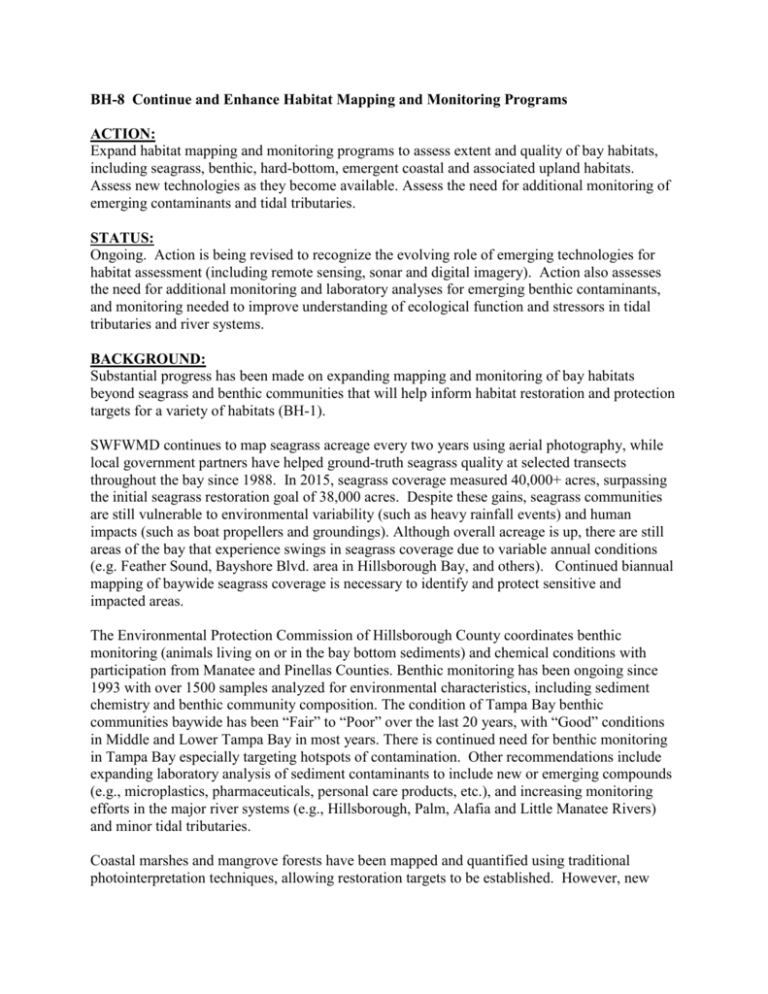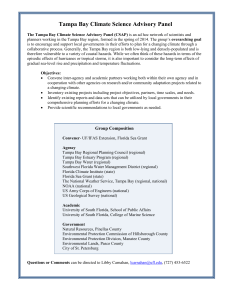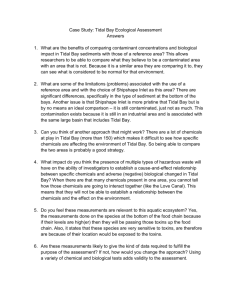BH-8 Expand Mapping and Monitoring Programs_ FINAL DRAFT_
advertisement

BH-8 Continue and Enhance Habitat Mapping and Monitoring Programs ACTION: Expand habitat mapping and monitoring programs to assess extent and quality of bay habitats, including seagrass, benthic, hard-bottom, emergent coastal and associated upland habitats. Assess new technologies as they become available. Assess the need for additional monitoring of emerging contaminants and tidal tributaries. STATUS: Ongoing. Action is being revised to recognize the evolving role of emerging technologies for habitat assessment (including remote sensing, sonar and digital imagery). Action also assesses the need for additional monitoring and laboratory analyses for emerging benthic contaminants, and monitoring needed to improve understanding of ecological function and stressors in tidal tributaries and river systems. BACKGROUND: Substantial progress has been made on expanding mapping and monitoring of bay habitats beyond seagrass and benthic communities that will help inform habitat restoration and protection targets for a variety of habitats (BH-1). SWFWMD continues to map seagrass acreage every two years using aerial photography, while local government partners have helped ground-truth seagrass quality at selected transects throughout the bay since 1988. In 2015, seagrass coverage measured 40,000+ acres, surpassing the initial seagrass restoration goal of 38,000 acres. Despite these gains, seagrass communities are still vulnerable to environmental variability (such as heavy rainfall events) and human impacts (such as boat propellers and groundings). Although overall acreage is up, there are still areas of the bay that experience swings in seagrass coverage due to variable annual conditions (e.g. Feather Sound, Bayshore Blvd. area in Hillsborough Bay, and others). Continued biannual mapping of baywide seagrass coverage is necessary to identify and protect sensitive and impacted areas. The Environmental Protection Commission of Hillsborough County coordinates benthic monitoring (animals living on or in the bay bottom sediments) and chemical conditions with participation from Manatee and Pinellas Counties. Benthic monitoring has been ongoing since 1993 with over 1500 samples analyzed for environmental characteristics, including sediment chemistry and benthic community composition. The condition of Tampa Bay benthic communities baywide has been “Fair” to “Poor” over the last 20 years, with “Good” conditions in Middle and Lower Tampa Bay in most years. There is continued need for benthic monitoring in Tampa Bay especially targeting hotspots of contamination. Other recommendations include expanding laboratory analysis of sediment contaminants to include new or emerging compounds (e.g., microplastics, pharmaceuticals, personal care products, etc.), and increasing monitoring efforts in the major river systems (e.g., Hillsborough, Palm, Alafia and Little Manatee Rivers) and minor tidal tributaries. Coastal marshes and mangrove forests have been mapped and quantified using traditional photointerpretation techniques, allowing restoration targets to be established. However, new approaches and techniques to capture large- and small-scale changes are required, especially for understanding and potentially mitigating for climate change. Several new monitoring techniques designed to detect small-scale changes resulting from climate change and sea level rise (SLR) are being tested and compared for effectiveness and cost-saving as part of the Critical Coastal Habitat Assessment initiated in 2014. Large-scale habitat changes could be detected using new automated digital aerial or satellite imagery processing techniques currently in development. If these techniques prove to be accurate, precise and cost-effective, high resolution aerial imagery currently being collected by SWFWMD could yield detailed habitat maps, and combined with digital elevation data could help assess the fate of low lying areas and identify opportunities to restore or purchase land so habitats can migrate landward in response to SLR. Mapping and monitoring of tidal flats and oyster communities began in 2012 as part of seagrass aerial surveys conducted by SWFWMD. Beginning in 2015, new standards for interpreting oyster reefs and tidal flats from aerial photography are being instituted for greater accuracy, and new survey techniques such as sidescan sonar and underwater video are being used to map hardbottom habitats, such as fossilized coral and limestone. Protection and restoration targets will be developed as part of the mapping effort to be completed by SWFWMD by mid-2016 (BH-4). Freshwater wetland habitat was mapped for the entire Tampa Bay watershed using land cover map products derived from aerial imagery taken in 1950 and 2007. Maps were analyzed to compare the change in quantity and quality of wetland habitat over time and show one-third of freshwater wetlands have been lost since 1950 (mostly non-forested wetlands). These data were used to help set restoration and protection targets and develop the Freshwater Wetland Habitat Master Plan (BH-10). In the Tampa Bay watershed, coastal uplands are important buffers between sensitive tidal wetlands and urban and agricultural development. Yet the status of coastal upland habitats in Tampa Bay has not been mapped in detail. Based on generalized land cover maps, an estimated 12,929 acres of coastal uplands occur in the Tampa Bay watershed, and improved quantitative assessments are needed to develop numeric targets for restoration. A comprehensive mapping program for invasive plants does not exist, although various agencies maintain some location-specific information about invasive plants on their environmental lands. These local data could be augmented via citizen science using mobile devices and apps. STRATEGY: Activity 1: Continue the existing mapping and monitoring programs. Continue to identify areas where coastal habitat recovery is lagging, highly variable, or threatened. Incorporate data and observations from existing mapping and monitoring programs (e.g. CCHA, seagrass mapping). Periodically summarize mapping and monitoring efforts for critical coastal habitats in a synthesis document such as, the Bay Environmental Monitoring Report (BEMR) or State of the Bay reports. Responsible Parties: Seagrass, tidal flats and oyster reef aerial coverage mapping: SWFWMD (lead) Land use/land cover mapping: SWFWMD (lead) Seagrass Transect monitoring: TBEP (lead coordinator) with implementing partners including SWFWMD, Manatee County, Pinellas County, EPCHC, Tampa Bay Watch Coastal habitats, low-salinity habitats and freshwater wetlands maps using SWFWMD land use/land cover data: TBEP (lead), with implementing partners of the CCHA Benthic monitoring: EPCHC (lead) with implementing partners Pinellas County and Manatee County Identify areas of concern: TBEP (lead) through Bay Habitat Master Plan every 5 years Periodically summarize mapping and monitoring results: TBEP (coordinator) with implementing partners including local governments, SWFWMD, FWC, USGS, FDEP, Tampa Bay Water. Timeframe: Ongoing Cost and potential funding sources: $$$. Ongoing mapping and monitoring programs are funded by local governments (EPCHC, Pinellas and Manatee counties), SWFWMD, and Section 320 funds (TBEP Habitat Masterplan, support for benthic monitoring programs). Periodic synthesis reports funded by 320 funds and staff time from contributing partners. Location: Baywide Benefit/Performance measures: Track conditions and trends in habitats throughout Tampa Bay Results: Detailed mapping and monitoring data on habitat extent and quality help set and assess targets. Deliverables: Reports (BEMR, State of the Bay) on status and trends in bay habitats and benthic communities Habitat Masterplan updates Activity 2: Use new technologies, as they emerge and are proven, to track habitat quantity and quality in the Tampa Bay watershed. Priority habitats include coastal marshes and mangrove forests, tidal creeks (BH-9, BH-11), oligohaline habitats and freshwater wetlands (BH-10), hard bottom and oyster reef communities (BH-4), and associated uplands, including natural, restored or created habitats. Support new efforts to map invasive plants using mobile devices (IS-2). Collaborate with private sector entities that may be using new technologies in their environmental monitoring programs. Responsible Parties: Apply new technologies, including sidescan sonar, for underwater habitat mapping: SWFWMD (lead) Apply new technologies, including aerial photo transects using drones, for coastal habitats status and trends: TBEP (lead) Evaluate mobile devises to map invasive plants in upland habitats: Florida Invasive Species Partnership (lead) Support evaluation of other new technologies as they become available: potential implementing partners include private companies, academic institutions, SWFWMD, EPA, FDEP Timeframe: Ongoing. Other technologies to be tested as they become available. Cost and potential funding sources: $$-$$$. Ongoing testing of new technologies are being funded by SWFWMD, TBERF, EPA Wetland Development Grant funds and Section 320 funds Location: Baywide Benefit/Performance measures: Apply new technologies to track conditions and trends in habitats throughout Tampa Bay Results: New technologies may result in more accurate and detailed data on habitat extent and quality to help set and assess targets. Deliverables: Reports on the effectiveness of new technologies to track status and trends in bay habitats and benthic communities Activity 3. Evaluate the need and feasibility for additional monitoring for emerging contaminants (such as microplastics, pharmaceuticals, personal care products) and expanding monitoring in rivers and tidal tributaries. Responsible Parties: TBEP TAC (lead) to evaluate and prioritize additional monitoring needs, and identify lead entities to implement additional monitoring. Timeframe: Initiate evaluations by 2020 Cost and potential funding sources: $ for evaluation: Section 320 funds. $$-$$$ for additional monitoring, if found to be needed. Potential funding sources for additional monitoring include TBERF, SWFWMD, USGS, NOAA, EPA Wetland Development Grant funds, EPA CWA (non-320) and Section 320 funds Location: Baywide Benefit/Performance measures: Need and feasibility of additional monitoring will be assessed. Results: New monitoring, if needed, may result in a better understanding of emerging contaminants and the function and condition of tidal tributaries. Deliverables: Report on the need and feasibility of additional monitoring









